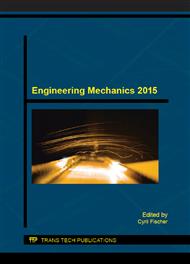[1]
COST Action 345: Procedures Required for the Assessment of Highway Structures. Final Report, Reports of Working Groups 1-6, COST Action 345, (2004).
Google Scholar
[2]
ČSN 73 6222: Load bearing capacity of road bridges, Praha: ÚNMZ, (2013).
Google Scholar
[3]
EN 1992-2: Design of concrete structures - Part 2: Concrete bridges - Design and detailing rules, Praha: ÚNMZ, (2007).
Google Scholar
[4]
EN 1990: Eurocode: Basis of structural design, 2. ed., Praha: ÚNMZ, (2011).
Google Scholar
[5]
ISO 13 822: Bases for design of structures - Assessment of existing structures, Praha: ÚNMZ, (2014).
Google Scholar
[6]
M. Holicky, M. Sykora, Conventional probabilistic models for calibration of codes. In Proc. ICASP11, eds. M.H. Faber, J. Köhler and K. Nishijima, Leiden: CRC Press/Balkema, 2011, pp.969-976.
Google Scholar
[7]
M. Sykora, M. Holicky, M. Prieto, et al., Model uncertainties in reliability verifications of reinforced concrete structures, Mater. Struct. (2014).
Google Scholar
[8]
R. Lenner, M. Sykora. Partial Factors for Loads due to Special Vehicles on Road Bridges (submitted in a revised form); In: Engineering Structures (2015).
DOI: 10.1016/j.engstruct.2015.10.024
Google Scholar
[9]
J. Krejsa, M. Sykora, Updating Partial Factors for Assessment of Historic Reinforced Concrete Bridge. In: Proceedings of extended abstracts – 13th international conference modelling in mechanics 2015, (2015), pp.63-64.
Google Scholar
[10]
A. O'Connor, I. Enevoldsen. Probability-based bridge assessment (2007), Proceedings of the Institution of Civil Engineers: Bridge Engineering, (2007), pp.129-137.
DOI: 10.1680/bren.2007.160.3.129
Google Scholar
[11]
D. Wisniewski, J. Casas, A. Henriques, P. Cruz. Probability based assessment of existing concrete bridges – stochastic resistance models and applications. Struct Eng Int 2009; p.203–210.
DOI: 10.2749/101686609788220268
Google Scholar
[12]
R. Caspeele, M. Sykora, D. Allaix, R. Steenbergen. The Design Value Method and Adjusted Partial Factor Approach for Existing Structures; In: Structural Engineering International 2013, pp.386-393.
DOI: 10.2749/101686613x13627347100194
Google Scholar
[13]
M. Sykora, M. Holicky, J. Markova. Verification of Existing Reinforced Concrete Bridges using a Semi-Probabilistic Approach; In: Engineering Structures 56(November 2013): pp.1419-1426.
DOI: 10.1016/j.engstruct.2013.07.015
Google Scholar
[14]
R. Steenbergen, M. Sykora, D. Diamantidis, M. Holicky, A. Vrouwenvelder. Target reliability levels for assessment of existing structures based on economic optimisation and human safety criteria (in press); In: Structural Concrete – Journal of fib 2015, Online.
DOI: 10.1002/suco.201500022
Google Scholar


